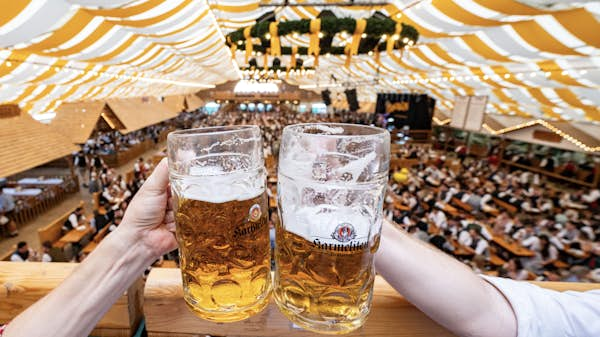Known largely to locals, these beer festivals all over the southern German state are among the biggest and liveliest in Europe in their own right.
No one can deny that Oktoberfest is the king of all beer festivals, attracting over 6 million annual visitors and making a significant contribution to the Munich economy.
Yet though the festival is epic, today visitor numbers are back to pre-COVID levels, accommodations get booked up a year in advance and a tankard of beer costs over €15. All of which makes the idea of sampling other beer festivals throughout Bavaria increasingly attractive. Known largely to locals, these beer parties might be called the “best of the rest” – though in truth they are some of the biggest and best beer festivals in Europe in their own right.

1. Gäubodenvolksfest, Straubing
Dating back to 1812, Straubing’s little-known Gäubodenvolksfest is in fact the second-largest folk (pronounced “beer”) festival in Bavaria after Oktoberfest – and this one has better weather and the occasional free seat. Over 11 days in August, the event attracts well over a million visitors – a mammoth number for an otherwise nondescript town of 50,000 people. That would make it the largest annual beer festival in the vast majority of the world’s beer-drinking nations.
As at Oktoberfest, there’s a fun fair and other distractions unrelated to the local hop-based beverages – yet it’s the 100,000 sq m (1,076,000 sq ft) of tent space shared between seven local breweries that draw crowds looking to quench their thirst in the August heat. What’s more, the beer costs around three-quarters of what it does at Munich’s better-known lager shebang – reason enough to head to this corner of eastern Bavaria.
2. Starkbierzeit, Munich
While Munich is known primarily for Oktoberfest, few know that the city hosts several other, smaller beer festivals throughout the year. The Starkbierzeit – literally “Time of Strong Beer” – originated in the 17th century, when Paulaner monks brewed strong, nourishing beer called Doppelbock to sustain themselves while fasting during Lent.
Still held in the run-up to Easter, this most pious of alcohol-based “fasts” isn’t held in at a single site, instead playing out at various breweries and taverns across the Bavarian capital. It’s also an evening thing, so forget those beer-and-chicken breakfasts of the Oktoberfest meadow. While the main dispensary remains the Nockherberg, where the whole thing started, many others get in on the act, brewing a serving special lager with an almost wine-like 7.5% alcohol content.

3. Dachau Folk Festival, Dachau
Joined at the hip with Munich, the town of Dachau is normally associated with the darkest days of the Nazis. But once a year the community puts all of its historical associations to one side to party. The Dachau Folk Festival takes place in mid-August on the town’s main square, where 300,000 drinkers gather to enjoy some of the most reasonably priced beer of any similar festival in the region.
4. Herbstfest, Erding
The third-largest beer festival in Bavaria takes place in the small commuter town of Erding. Does that name ring a bell? That’s probably because your local supermarket stocks Erdinger Weissbier, for many the best wheat beer in the world. The huge brewery in town brews up millions of gallons of wheat lager a year, making it the world’s largest producer. The Herbstfest takes place in the first week of September, getting Oktoberfest drinkers in the mood for the big event to come two weeks later. A one-liter tankard of local wheat beer runs a third of the price of one at Oktoberfest, and the Erding atmosphere is more family-oriented. So get out your best lederhosen or dirndl a bit early, and hop on the S2 S-Bahn line for this wheat-beer preview of Oktoberfest.

5. Frühlingsfest, Munich
If springtime beer in Munich appeals, Frühlingsfest (Spring Festival) is for you. Held since 1965 on the same hallowed gravel as the Oktoberfest (the Theresienwiese, near Munich’s main railway station), it’s but a baby in the Bavarian beer-festival world. A kind of rehearsal for the main event later in the year, the Spring Festival is also a massive event in its own right. Arriving just after Starkbierzeit, it’s the first big outdoor folksy fun of the year, featuring a fair, fireworks and a famous flea market. Beer lovers should know that not all of Munich “big six” breweries take part, and a 1L stein comes in at almost the same price as at Oktoberfest. Yet there’s still plenty of beer to go around.

6. Small-town festivals throughout Bavaria
Just about every town and many villages in Bavaria hold their own beer bashes, usually under the name Volksfest (folk festival), Dult (fair) or Kirchweih (church fair). These celebrations combine traditional culture with the beer-brewing customs of the region in a way that can only happen here. Many take place in the autumn, which historically coincided with the harvest. You’ll find them from Weiden to the Alps, Bamberg to Rosenheim: check out this website for the full list.

